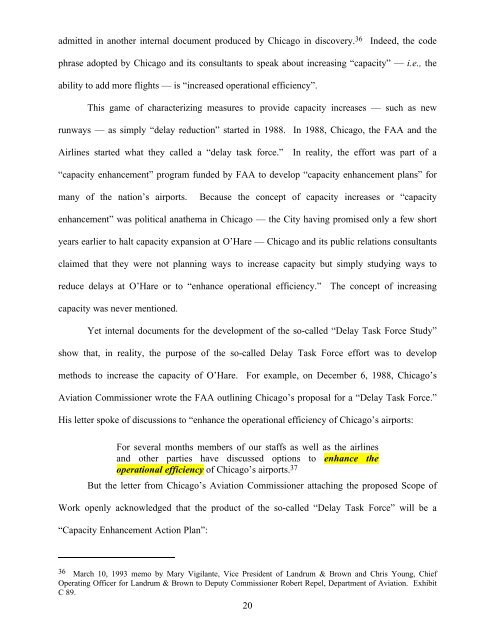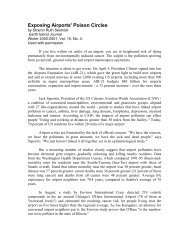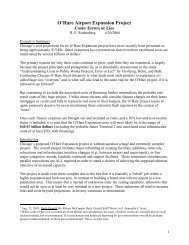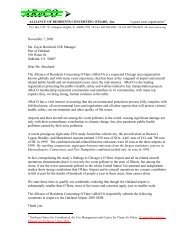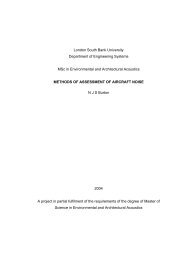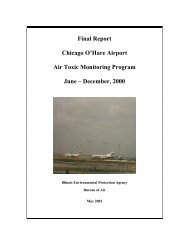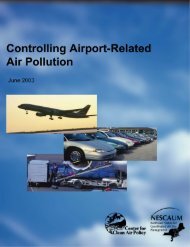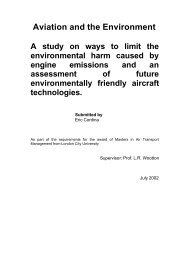evidentiary appendix in support of plaintiffs' partial motion for ...
evidentiary appendix in support of plaintiffs' partial motion for ...
evidentiary appendix in support of plaintiffs' partial motion for ...
You also want an ePaper? Increase the reach of your titles
YUMPU automatically turns print PDFs into web optimized ePapers that Google loves.
admitted <strong>in</strong> another <strong>in</strong>ternal document produced by Chicago <strong>in</strong> discovery. 36 Indeed, the code<br />
phrase adopted by Chicago and its consultants to speak about <strong>in</strong>creas<strong>in</strong>g “capacity” — i.e., the<br />
ability to add more flights — is “<strong>in</strong>creased operational efficiency”.<br />
This game <strong>of</strong> characteriz<strong>in</strong>g measures to provide capacity <strong>in</strong>creases — such as new<br />
runways — as simply “delay reduction” started <strong>in</strong> 1988. In 1988, Chicago, the FAA and the<br />
Airl<strong>in</strong>es started what they called a “delay task <strong>for</strong>ce.” In reality, the ef<strong>for</strong>t was part <strong>of</strong> a<br />
“capacity enhancement” program funded by FAA to develop “capacity enhancement plans” <strong>for</strong><br />
many <strong>of</strong> the nation’s airports. Because the concept <strong>of</strong> capacity <strong>in</strong>creases or “capacity<br />
enhancement” was political anathema <strong>in</strong> Chicago — the City hav<strong>in</strong>g promised only a few short<br />
years earlier to halt capacity expansion at O’Hare — Chicago and its public relations consultants<br />
claimed that they were not plann<strong>in</strong>g ways to <strong>in</strong>crease capacity but simply study<strong>in</strong>g ways to<br />
reduce delays at O’Hare or to “enhance operational efficiency.” The concept <strong>of</strong> <strong>in</strong>creas<strong>in</strong>g<br />
capacity was never mentioned.<br />
Yet <strong>in</strong>ternal documents <strong>for</strong> the development <strong>of</strong> the so-called “Delay Task Force Study”<br />
show that, <strong>in</strong> reality, the purpose <strong>of</strong> the so-called Delay Task Force ef<strong>for</strong>t was to develop<br />
methods to <strong>in</strong>crease the capacity <strong>of</strong> O’Hare. For example, on December 6, 1988, Chicago’s<br />
Aviation Commissioner wrote the FAA outl<strong>in</strong><strong>in</strong>g Chicago’s proposal <strong>for</strong> a “Delay Task Force.”<br />
His letter spoke <strong>of</strong> discussions to “enhance the operational efficiency <strong>of</strong> Chicago’s airports:<br />
For several months members <strong>of</strong> our staffs as well as the airl<strong>in</strong>es<br />
and other parties have discussed options to enhance the<br />
operational efficiency <strong>of</strong> Chicago’s airports. 37<br />
But the letter from Chicago’s Aviation Commissioner attach<strong>in</strong>g the proposed Scope <strong>of</strong><br />
Work openly acknowledged that the product <strong>of</strong> the so-called “Delay Task Force” will be a<br />
“Capacity Enhancement Action Plan”:<br />
36 March 10, 1993 memo by Mary Vigilante, Vice President <strong>of</strong> Landrum & Brown and Chris Young, Chief<br />
Operat<strong>in</strong>g Officer <strong>for</strong> Landrum & Brown to Deputy Commissioner Robert Repel, Department <strong>of</strong> Aviation. Exhibit<br />
C 89.<br />
20


